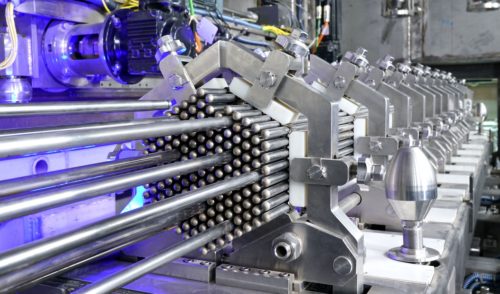
Accelerator opens up new horizons
back to contentsThe system is the only of its type in Russia and is the best charged particle accelerator in its class globally. The tandetron acceleration system (full name: 3MV Tandetron 4130 MC+(HC)) was produced for the Institute of Physics and Power Engineering by High Voltage Engineering Europa B.V., a Dutch company specializing in research and industrial accelerators. The system was fine-tuned after the delivery to Obninsk to suit the customer’s needs, with the fine-tuning process assisted by local engineers. The tandetron accelerator is unparalleled in its class as it can, first of all, operate in a continuous mode.
Second, the system can accelerate a broad range of particles (from protons to gold isotopes) with energies up to 3 MeV. Experts say that its actual capacity is much higher. In particular, the tandetron accelerator is capable of accelerating particles of almost any element, with ion energies exceeding the rated level of 3 MeV.
Finally, the third unique feature of the system is its capacity to generate a very narrow (up to several millimeters) ion beam. All the three features make the tandetron accelerator applicable to a wide variety of research tasks.
First of all, it will be used in experimental areas of nuclear physics. In particular, researchers plan to verify certain nuclear reactor parameters with its help. This task is of great importance for the Institute of Physics and Power Engineering as it was here where the world’s first commercial nuclear station (Obninsk NPP) was put in operation. The institute remains a leader in nuclear power engineering, focusing on fast reactor technologies (BN-600 and BN-800 reactors at Beloyarsk NPP).
The tandetron accelerator system will be also used in research of applied nuclear technologies. These include, among others, calibration of neutron detectors, detection of water in oil products, and analysis of protective coating structures for nuclear reactors. Another promising application of the accelerator is radiation material science. In particular, researchers plan to utilize it in the radiation doping (ion bombardment) of silicon plates used to make transistors and diodes. Irradiated semiconductors have much better performance than their conventional counterparts.
And finally, the accelerator will be used for medical purposes. It will produce short-lived isotopes for positron emission tomographs in medical centers located in Central Russia (more remote locations remain out of scope since isotopes will decay). The tandetron accelerator will also be employed in neutron beam therapy of malignant tumors. This therapy includes the following steps: boron is introduced in affected tissues, which are then bombarded with neutrons by the accelerator. Boron captures neutrons, decays and kills malignant cells. Healthy tissues are not affected by this local therapy.
The Institute of Physics and Power Engineering has conducted experiments on animals and found them to be a success. The equipment has been fine-tuned, and the institute is now ready to kick off the project, which is so important for the national nuclear medicine. Plans are to treat up to 4,000 patients annually from all over Russia. Therapy costs will be many times lower than those of peers.
“The new accelerator installed in Leipunsky Institute will be used to obtain a broad range of ions – from hydrogen to gold. It opens a new stage of research, development and medical treatment to bring benefits to the nuclear industry and the entire country,” Andrei Goverdovsky, General Director of Leipunsky Institute, concludes.




